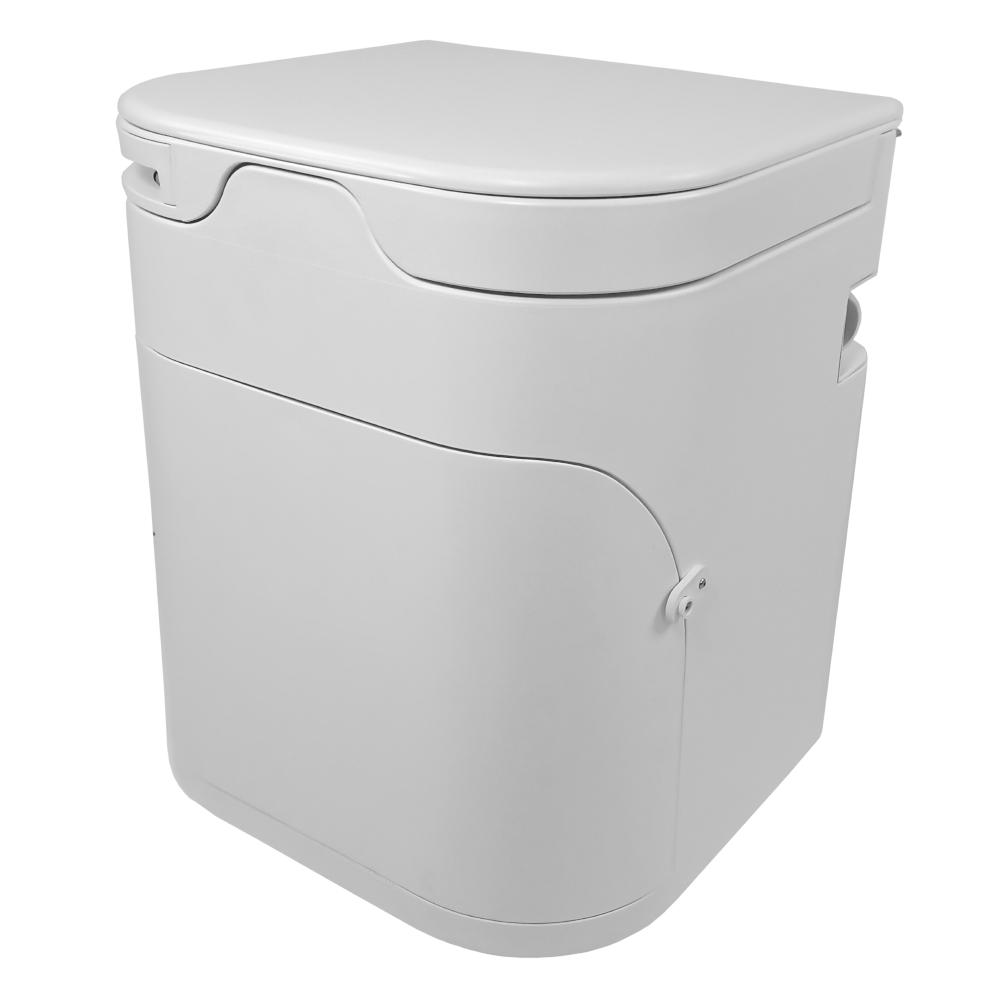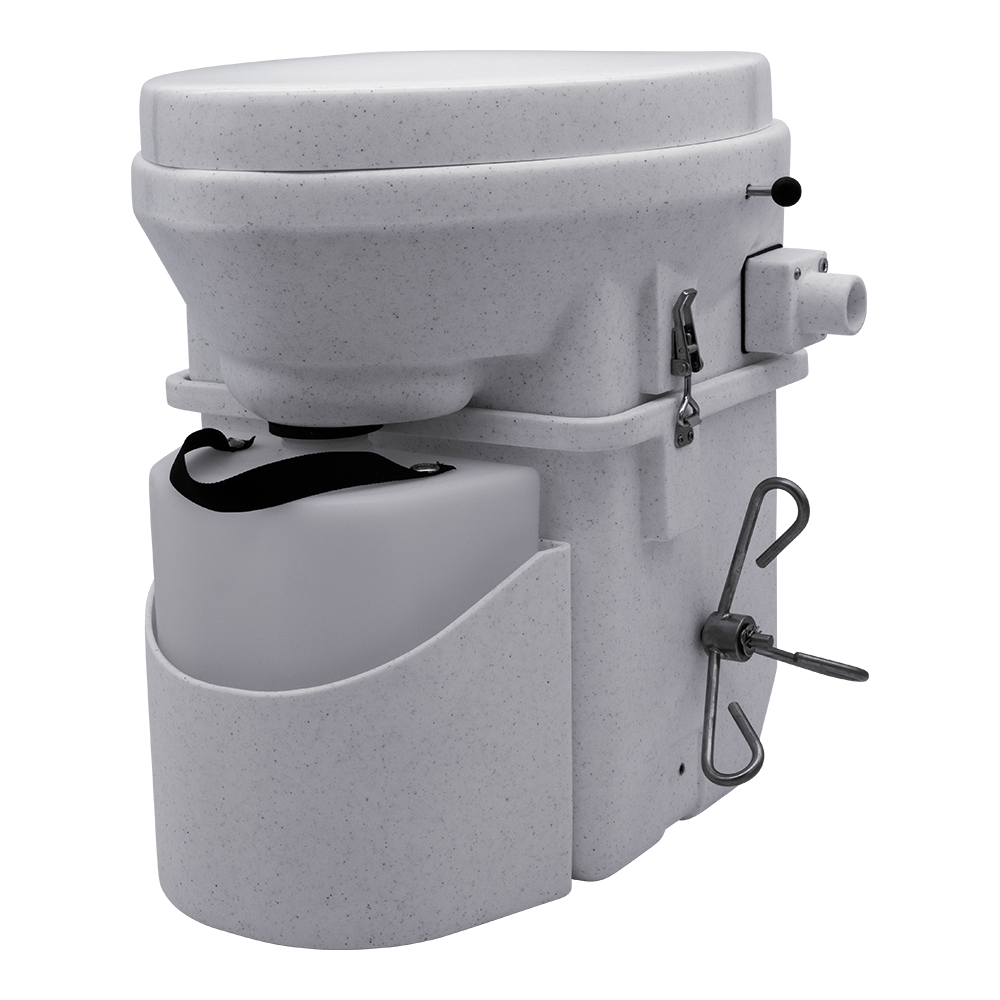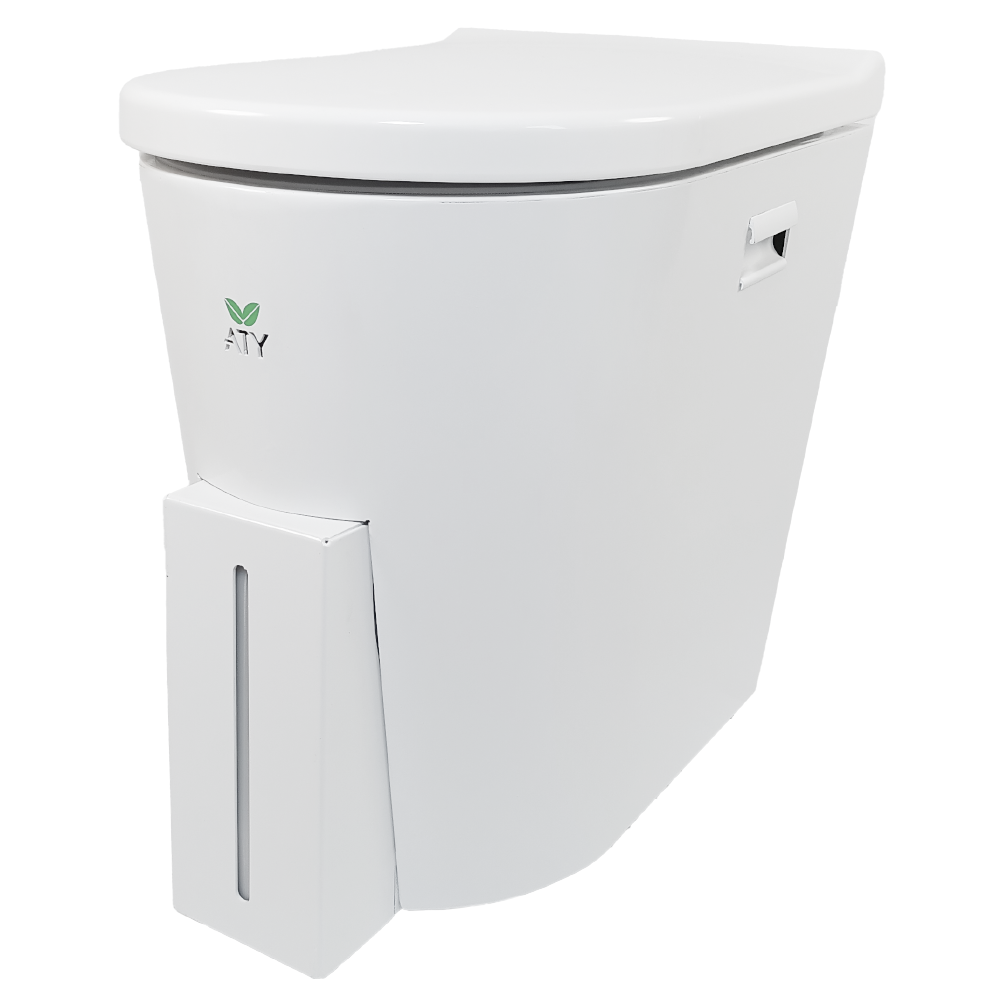How do urine-diverting toilets in the home work?
A separating toilet in the house or tiny house works in the same way as a classic toilet with a water and sewer connection. The difference to a dry urine-diverting toilet is that it requires neither water nor a connection to the sewerage system. A composting toilet, such as our OGO Origin, is best suited for use in the home, as it has a large capacity and therefore needs to be emptied less frequently. This urine-diverting toilet is also permanently installed in the bathroom, just like a normal toilet. The only connection required here is the power supply. An exhaust air hose is also fitted, which is ideally led outside. A composting toilet has a separator insert that separates the urine from the solids as soon as it is used with the help of a urine drain. This immediate separation and covering of the solid waste means that no odours are produced in the bathroom. The practical thing about a composting toilet is that the litter is filled into the solids container in advance. After going to the toilet, the built-in agitator is activated at the touch of a button or using the hand/foot crank. This ensures that fresh litter is transported upwards and the solids are covered. This eliminates the need for manual re-scattering, as is usual with a classic separating toilet. This process, in combination with the constant drying, ensures that the solids container only needs to be emptied after approx. 6 weeks, depending on the model. This is also possible on the composter. After composting, the result is valuable hummus. The urine container of the dry separating toilet should be emptied after 3 days at the latest, depending on requirements.
Are indoor urine-diverting toilets hygienic?
Yes, urine-diverting toilets, dry urine-diverting toilets or dry toilets are just as hygienic as a conventional toilet with a water connection. As with a conventional toilet, you never come into contact with faeces, neither when using the toilet nor afterwards. The built-in separator insert ensures that the urine is separated from the solids during use and discharged into two separate containers. This separation enables both components to be disposed of hygienically. The liquid collected in the urine container can be disposed of in the drain or in your own garden. If the urine is diluted with water, it is an excellent ecological fertiliser for non-edible plants. In a separating toilet, faeces are collected in a solids container, which is usually lined with a bag in a conventional dry separating toilet. After using the toilet, the faeces are covered with a substrate to prevent odours. Once the bag has reached its filling volume, it can be tied up and disposed of in the residual waste. If a composting toilet is chosen, the solids container is not lined with a bag as this would interfere with the function of the agitator. With this option, the loose substrate must first be transferred to a bin liner before it can be disposed of in the residual waste. An alternative is to dispose of the used litter in your own composter. This allows you to compost the faeces and maintain the natural cycle.
Can I use my urine-diverting toilet in the house?
Yes, in principle any separating toilet is suitable for your own home or tiny house. You should consider in advance whether the dry toilet will be purchased for permanent use or as an "emergency toilet". If the dry separation toilet is to replace the conventional toilet 1:1, a composting toilet is best suited for permanent installation. Composting toilets also have a separating insert and two different containers in which the faeces are collected separately. One advantage of these models is that the solid waste container has a built-in agitator, which takes over the function of re-littering. The litter is filled into the container in advance. It also ensures that the toilet has a range of up to 6 weeks for 2 people in continuous use. This means you don't have to plan much time for simple emptying. This version of the urine-diverting toilet can be used like a conventional toilet, but without a water and sewer connection. If you don't have much space, for example in a tiny house, or only need the toilet in an emergency, you can opt for a portable compact urine-diverting toilet. As these toilets do not have an agitator, the solids have to be covered with litter by hand after using the toilet. Due to the small size and therefore smaller canisters, emptying is necessary after a few days. With both models, the toilet paper can be disposed of in the toilet.
How does urine-diverting toilet ventilation work in the home?
Ventilation for urine-diverting toilets, especially composting toilets, is very simple, whether in a house or a tiny house. A power connection and a connection for the exhaust air hose are required for the ventilation to work properly and odour-free. For the best possible ventilation, the hose should be routed to the outside. The fan, which is located on the other side of the solids container and is powered by electricity, works in combination with the exhaust air hose to ensure that the faeces are constantly dried and therefore completely odour-free. If it is not possible to place the ventilation outside, there is a special filter. This is attached to the end of the hose to ensure that no odours from the dry toilet can escape into the bathroom.
Comparison of urine-diverting toilets for the home
Basically, any model of urine-diverting toilet is suitable for your own home or tiny house. Both variants, classic or higher quality, have their advantages and disadvantages. However, a composting toilet is best suited for the bathroom in a private home, as it has the greatest range and can be used like a classic toilet without much effort.
| Portable separating toilet | Fixed composting toilet |
| With bag | Without bag |
| No pre-composting | Pre-composting |
| No solids flap | With solids flap |
| Spreading by hand | No need to re-spread |
| Without agitator | With agitator |
| Without power connection | With power connection |
| Optional fan | Not optional fan |
| Suitable for almost any litter | Coconut fibres recommended |
| Small urine container | Large urine container |
Designs of dry urine-diverting toilets for homes
There are a variety of designs, depending on the material, the installation and the model of the urine-diverting toilet. Any dry toilet is suitable for a tiny house or owner-occupied home, which is why you have a free choice here. If you only want to use the urine-diverting toilet occasionally, a compact, portable toilet is the best choice. Our OGO Nomad S made of plastic or ATY Move made of metal are designed for such purposes. If you want something a little more natural, you can also opt for a wooden dry separation toilet. If the toilet is intended for permanent use, the composting toilet is the right choice. This model is permanently installed but not connected to the sewage system and works without water or chemicals. Here, too, you have a choice of different materials and designs. The OGO Origin and Nature's Head are particularly suitable for this purpose. If you want a urine-diverting toilet that looks as much like your usual toilet as possible, you should opt for our metal ATY Move.



What is the odour like with domestic urine-diverting toilets?
If the dry urine-diverting toilet is operated properly and correctly, there is no odour. The separation insert separates the faeces from each other as soon as the urine-diverting toilet is used and they are collected in the container provided for this purpose. This separation and the advantage that no water or chemicals are required ensure that the toilet remains odour-free. It is important for this odourlessness that the faeces are covered with litter immediately after using the toilet. This prevents gases from developing and suppresses the formation of odours. It is also important that the humidity in the dry toilet is very low and does not become too high. A composting toilet only needs to be emptied after several weeks. Here, the constant drying of the solids ensures that the faeces do not become too moist and the range can be reached. If no medication or special foods, such as asparagus, are consumed, urine itself is odourless. The urine is drained into an extra container and therefore does not come into contact with other faeces. This canister should be emptied and dried out after three days at the latest so that no odours develop. There is no need to clean it, as any water residue can lead to an unpleasant ammonia odour.